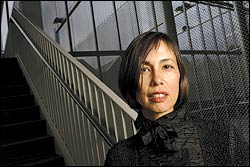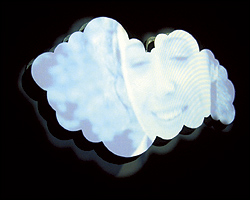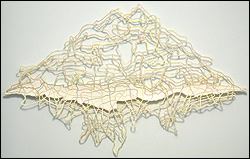Taking a tour of Seattle Art Museum’s expansion—currently under construction in the new Washington Mutual Tower—requires an act of visualization. Shiny ductwork crowds the floor. Steel girders are flocked with globs of fire- resistant insulation. The constant screech of saws cuts the air. Much of what visitors will see when the expansion adds 70 percent more exhibition space to SAM in 2007 is still left to the imagination. But having a docent with a vision helps immensely.
My guide is new Deputy Director of Art Chiyo Ishikawa. She clearly has a vision, and is passionate in describing it. Clad in a hard hat and yellow raincoat, the energetic curator winds through the new space, painting a verbal portrait of the galleries. Here, she points out, will be a high-ceilinged gallery for art from the 1980s. There, a room filled floor-to-ceiling with 18th-century porcelain. Over there, an African coffin in the shape of a car, suspended from the ceiling. What will fill the sleek, no-frills expansion is largely her responsibility.
Ishikawa was selected as deputy director in June to replace Lisa Corrin, who took a job with Williams College Museum of Art. Although Ishikawa is taking a more public role, she’s not exactly a new face at the museum. She arrived at SAM as an assistant curator in 1990 after stints with the Metropolitan Museum of Art and the Museum of Fine Arts in Boston. Born in Wisconsin, Ishikawa is the second generation in her family to pursue a museum career—her father was with the Des Moines Art Center in Iowa.
A family trip to Europe when she was 12 inspired a lifelong fascination with art. Her specialty (she earned her Ph.D. from Bryn Mawr) is early Dutch and Flemish painting, and she was a lecturer on Northern European painting at the University of Washington. As SAM’s curator of European painting and sculpture, she’s been involved in more than a dozen exhibitions, organizing large shows of impressionism, Dutch masters, and Leonardo da Vinci’s Codex Leicester.
Most recently, she was the driving force behind last year’s “Spain in the Age of Exploration,” which brought 300 years of Spanish art to Seattle. “That was a lesson in diplomacy,” she says of the three-year project. “I had to listen to a lot of people— to our audience, to the concerns of Spanish officials. It really required seeing someone else’s point of view.”
That diplomatic approach may serve her well as she tries to manage a staff of curators with very different missions, while also serving up art that pleases a variety of audiences—from fans of African art to devotees of contemporary painting. “A curator has to be an agent of compromise,” she insists. “As a general museum, we have to serve various constituencies. If they haven’t seen something they’re interested in after two years, they feel left out.”
The audience is important to Ishikawa, and she supports outreach approaches that are anathema to some old-school curators. Because a good percentage of SAM’s revenue comes from admissions and memberships, she believes the museum can’t curate in a vacuum. That means involving people like education directors in curating decisions, or even—as in the case of the Spain show—conducting focus groups.
But Ishikawa is a sharp curator who believes that complex exhibits and high attendance aren’t mutually exclusive. “We did turn down that Star Wars exhibition,” she says, referring to a pointless Smithsonian exhibit that’s been a hit wherever it tours. “We have a duty to challenge people.” Ishikawa may be a good listener, but she can also talk—at length—about art. She once led me through the Spain exhibit and was a mobile encyclopedia, describing the nuances of Spanish and Flemish art. Touring the construction site, on what she fondly calls “my floor,” she describes several pet projects, including the installation of a complete 17th-century Italian wood-paneled room and a floor-to-ceiling display of over 1,000 pieces of porcelain. She has a passion for the details.
As deputy director, Ishikawa will still be responsible for the details of the museum’s European collection. But because it’s a relatively small part of SAM’s program, she’ll presumably have time and energy (of which she seems to have a boundless supply) to focus on the expansion. By choosing Ishikawa, SAM made it clear that whoever fills the other half of Corrin’s role—the crucial job of curator of modern and contemporary art—will have a free hand to curate without having to oversee three major capital projects: the expansion, the Olympic Sculpture Park, and an overhaul of the Seattle Asian Art Museum.
Ishikawa and the museum’s director, Mimi Gates, are leading an ambitious acquisition campaign prior to the 2007 reopening. This effort is already yielding fruit. The museum has announced major donations of contemporary glass, Native American baskets, West African masks, and a 16th-century mannerist painting from a noted New York collector.
Ishikawa sees the recent expansion of the Museum of Modern Art as an exemplar for organizing the permanent exhibitions. “In the old MOMA, nothing felt connected to anything else,” she says. She’s also dismissive of the approach favored by the downtown museum’s original architect, Robert Venturi, who preferred jarring juxtapositions: Northwest Coast native art next to Andy Warhol leading to a dose of Chinese landscape. Ishikawa’s approach will be more interpretive and connection-focused. “We want to open with a whole vision, not just a bunch of individual visions.”
On our tour of the construction site, we come to a spot (now just bare concrete) where the European and African galleries will intersect. Ishikawa tells me she wanted an artwork that would bridge the gap—”but we had nothing on the European experience of Africa.” To ease the transition, the museum acquired a 19th-century French painting of an African—a piece, she says, both accomplished and filled with anguish. That’s the sort of cross-cultural investigation visitors may find different in SAM’s newly configured downtown home. “There’s bound to be variety,” Ishikawa says, “but we want it to all make sense.”
Seattle Art Museum, 206-654-3100, www.seattleartmuseum.org.







